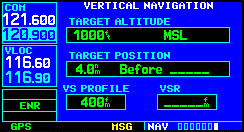I think you are totally missing my point 
What’s there to miss?
I fly a stabilized approach, which means I fly a stabilized IAS (that doesn’t mean i fly slow). According to the change in GS i set my VS to stay on the GS. And I check my altitudes. That’s how i was taught.
Please clarify your point.
Maintaining a constant VS and change GS to maintain a glide angle sounds like a dangerous approach to me. One could get into a stall if the wind changes from a headwind to a tailwind.
I’ve never tried it, but you could set a DCT to the MAP and use the VNAV function on the G430/G1000 to get vertical guidance:

Peter wrote:
The normally taught method is probably to increase VS, because there is a limit to how much you can slow down.
Yes. The textbook (at least according to “my” textbook) way of flying an NPA, especially in a high performance aircraft where the speed difference between fully configured and clean can be a factor of two or more, goes like this: Approaching the final descent point, the aircraft is slowed down and configured in defined stages (when and how depends on the model of course) so that the FAF is reached fully configured for landing and at an IAS of Vref + X, with X being determined by wind and gusts. That speed will slavishly be maintained all the way down until approaching the threshold. Shortly before passing the FAF it can be helpful to look at the ground speed and determine an initial rate of descent from that. Descend with that rate until passing the first check altitude and then slightly adjust the rate. Do not necessarily aim to be on your profile when reaching the next check altitude – at least as long as you are above profile – because this may result in large variations of rate which tend to de-stabilise the approach. Typically with average winds and something that descends at 100KIAS your approach will begin with maybe 450ft/min and end with 600 over the theshold and 8 NM in between for the tiniest of adjustments. Not really rocket science 
NB: In my experience, whether you fly this kind of thing using the point&power method or the other one does not make much of a difference. Personally, I only fly point&power with any type of aeroplane since decades and it works well for me.
I fly IAS (doesn’t everyone??) and adjust VS to stay on the profile.
Where did this talk about flying to a ground speed come from? Very odd.
Exactly, Jason. That’s really the most basic of the basics to fly Vref+gust factor and to adjust the VS according to the GS …
The GTN 750 in the plane I fly make perfect glideslope indication on the HSI all the way.
I actually tried it down to 50’ with my instructor on a PFC with ok from ATC.
I hate to be picky, but when you say
Peter wrote:
Yes but (in this context) you aren’t allowed to use a GPS on a traditional IR checkride
I might counter with the answer that you would have a hard job flying the GNSS20 at Shoreham (the plate in your earlier post) without doing so! 
I appreciate your comment is intended to be of a more general nature, but on my recent IR renewal I could have flown a GNSS approach as the NPA, the examiner left it to me.
On the Initial LSTs for the Citation and King Air type ratings (which include an IR for the type) I have done in the last year it has all been done using the full capabilities of the avionics, although one must have the underlying nav aid displaying on one of the pointers.
…although one must have the underlying nav aid displaying on one of the pointers.
If there are underlying navaids. I fly GPS based NPAs day in day out and the majority of them do not have such navaids. And even if so, our examiners (apart from the guys at Farnborough of course…) couldn’t care less.
but on my recent IR renewal I could have flown a GNSS approach as the NPA, the examiner left it to me.
IR revalidations are under different rules here. You can fly more or less as you normally would, except an ILS has to be hand flown.
The GTN 750 in the plane I fly make perfect glideslope indication on the HSI all the way
Of course, if you have a GPS which can do that 
Or if you have a “W” GPS, the IAP has an advisory (LNAV+V) glideslope in the database, there is no BARO-VNAV approach published (if there is, it will inhibit the +V being flown), then you have an “ILS”-like guidance all the way to the MDA.
There is also the Android GPS-ILS app which is, ahem, interesting and controversial, especially as nobody will say how the database was generated.
But I wasn’t talking about any of that. I was talking about flying a NP IAP with the autopilot doing the LNAV and doing VS hold.